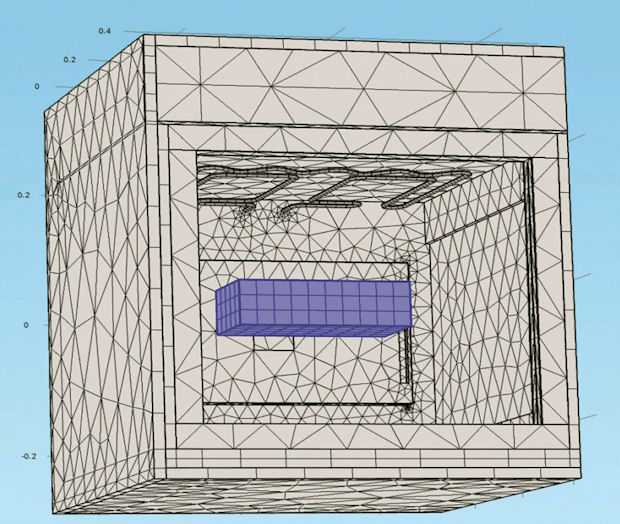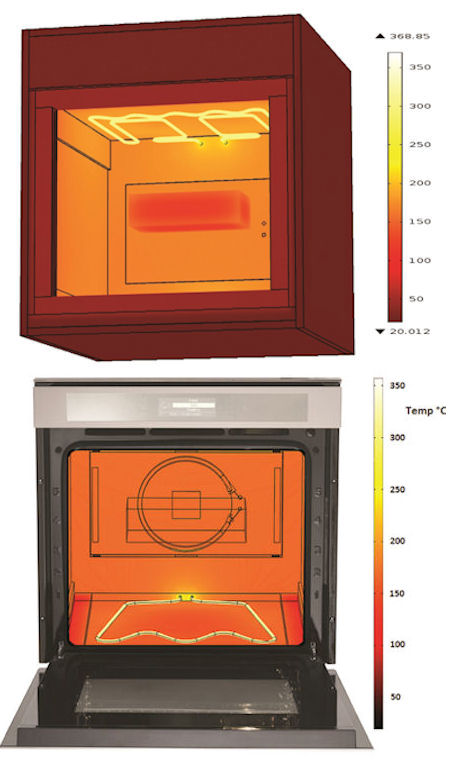
Whirlpool engineers created a “heat and mass transfer” module and a “transport of dilute species” module in their simulations to improve an oven’s energy efficiency.
Latest News
November 1, 2014
 Whirlpool engineers created a “heat and mass transfer” module and a “transport of dilute species” module in their simulations to improve an oven’s energy efficiency.
Whirlpool engineers created a “heat and mass transfer” module and a “transport of dilute species” module in their simulations to improve an oven’s energy efficiency.It’s difficult to separate family life and work for Nelson R. Garcia-Polanco. His home in Milan, Italy, is equipped with Whirlpool ovens and washers—the ones he and his colleagues designed. Garcia-Polanco, an engineer at Whirlpool, sometimes find himself cooking pizzas with an oven from the same line he’s been trying to redesign for energy efficiency.
For his family, an oven that can cook the same meal using less energy means a smaller electric bill. For Whirlpool, energy efficiency is part of its efforts to procure a higher-level European Union Energy label. In partnership with the Green Kitchen project, Whirlpool has begun an initiative to develop cutting-edge products that offer high energy efficiency and reduced impact on the environment. “[The] strategy of maximizing energy efficiency helps consumers reduce waste and achieve savings of up to 70% on energy bills,” announces Whirlpool.
To figure out ways to reduce energy use by Whirlpool ovens, Garcia-Polanco and his colleagues Joaquín Capablo and John Doyle run physical tests and thermal simulations in parallel. In digital simulation, engineers could easily do what’s usually time-consuming and costly in physical experiments. They could, for instance, alternate the materials and coatings in the oven walls to see how it affects the cooking process.
But before engineers can experiment with what-if scenarios on a computer, they must first cook a piece of brick, literally.
Marinate the Brick
To make an oven more energy-efficient, Garcia-Polanco and his Whirlpool colleagues must first study what happens inside the cavity of the appliance during the cooking process. The standard test for this in the European Union (EN 50304) is to cook a brick. It’s a solid piece of heat-conductive material, capable of retaining water, and manufactured to closely resemble the characteristics of generic food—making it an ideal substitute for controlled testing of the heating process.
Eight hours before the test, Garcia-Polanco soaked the brick in cold water. The brick absorbed about 5 oz. of water overnight. “Most food contains water,” Garcia-Polanco explains. “And that water evaporates during cooking. The evaporation also increases the heat transfer inside the oven.”
The shape, size and functions of the oven are normally standardized. For example, the position of the broiler is often fixed (usually attached to the roof). So one of the strategies is to try out different wall materials and coating options to change the reflectivity, conductivity and emissivity of the oven cavity.
The engineers’ plan was to use the brick test as reference, then run a number of simulations using COMSOL Multiphysics software. To obtain data from the physical test, the brick was rigged with thermocouples, feeding right into a data-logging device.
Running the Numbers
Taking detailed measurements from the brick test gave Whirlpool engineers a second-by-second account of what occurs inside the cavity. Engineers have a record of what happened inside the oven as the brick heated up to 392°F over the course of 50 minutes—including the velocity of the air flowing around the brick. “That data gave us the ability to set up a transient simulation, so we could recreate the cooking almost second by second, or for every 10-second interval,” Garcia-Polanco says.
 The digital simulation gave engineers temperature evolution over time. The results corresponded to the physical test conducted with a brick.
The digital simulation gave engineers temperature evolution over time. The results corresponded to the physical test conducted with a brick.The two types of numerical simulation employed are “heat and mass transfer” and “transport of dilute species.” The scenario involves non-linear, non-steady-state, partial differential equations. The oven model selected for the exercise is a European model with a 74-liter cavity, operated via a touchscreen.
The correlation between the behavior in the physical test and the digital simulation’s output gave Whirlpool engineers confidence in the accuracy of the computation. For example, by measuring the weight of the brick before and after the experiment, engineers could account for water loss during cooking. That figure matched the values produced by software simulation.
Checking the Glass
One of the culprits for heat loss during cooking turns out to be the glass door. “We know it’s important for the cook to be able to look inside while the oven is operating,” acknowledges Garcia-Polanco. “But the glass door is also responsible for radiation leaks, so a lot of heat is wasted.”
Simulation in the COMSOL software points to three possible approaches to improve the oven’s performance:
1. Figure out a way to change the glass’s emissivity.
2. Experiment with the dimensions of the walls.
3. Try out different wall properties by using different materials.
“We are still working on reaching our 20% energy reduction goal,” Garcia-Polanco reports. “We’re about halfway there.”
The next step in the team’s plan is to employ parametric studies and design optimization, driven by simulation software.
In the paper written about the experiment (“Multiphysics Approach of the Performance of a Domestic Oven”), Garcia-Polanco and his colleagues note the advantages that come with “the option to use coupled physic models (as, for example, mass and thermal transport), the use of established boundary conditions or the possibility to estimate the prediction error.” In this case, they were made possible by COMSOL Multiphysics software.
“Ovens are one of the worst appliances for energy efficiency in the kitchen,” Garcia-Polanco concludes. “It’s not easy to get to the A+ energy class.”
If he succeeds at work, Garcia-Polanco will be able to cook his pizzas at home with approximately 20% less energy.
More Info
Subscribe to our FREE magazine, FREE email newsletters or both!
Latest News
About the Author
Kenneth Wong is Digital Engineering’s resident blogger and senior editor. Email him at [email protected] or share your thoughts on this article at digitaleng.news/facebook.
Follow DE





